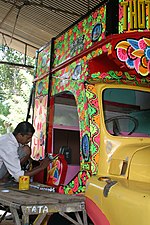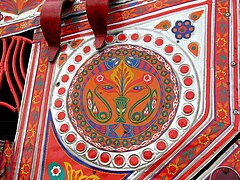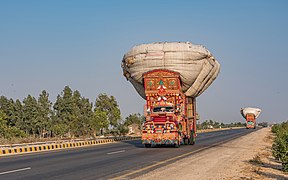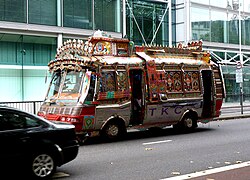
Karachi is the capital city of the Pakistani province of Sindh. It is the largest city in Pakistan and the 12th largest in the world, with a population of over 20 million. It is situated at the southern tip of the country along the Arabian Sea coast and formerly served as the capital of Pakistan. Ranked as a beta-global city, it is Pakistan's premier industrial and financial centre, with an estimated GDP of over $200 billion (PPP) as of 2021. Karachi is a metropolitan city and is considered Pakistan's most cosmopolitan city, and among the country's most linguistically, ethnically-, and religiously-diverse regions, as well as one of the country's most progressive and socially liberal cities.

Sindh is a province of Pakistan. Located in the southeastern region of the country, Sindh is the third-largest province of Pakistan by land area and the second-largest province by population after Punjab. It is bordered by the Pakistani provinces of Balochistan to the west and north-west and Punjab to the north. It shares an International border with the Indian states of Gujarat and Rajasthan to the east; it is also bounded by the Arabian Sea to the south. Sindh's landscape consists mostly of alluvial plains flanking the Indus River, the Thar Desert of Sindh in the eastern portion of the province along the international border with India, and the Kirthar Mountains in the western portion of the province.

Hyderabad is a city and the capital of Hyderabad Division in the Sindh province of Pakistan. It is the second-largest city in Sindh, and the fifth largest in Pakistan.

Sindhis are an Indo-Aryan ethnolinguistic group who speak the Sindhi language and are native to the Sindh province of Pakistan. The historical homeland of Sindhis is bordered by the southeastern part of Balochistan, the Bahawalpur region of Punjab and the Kutch region of Gujarat. Having been isolated throughout history, unlike its neighbours, Sindhi culture has preserved its own uniqueness.
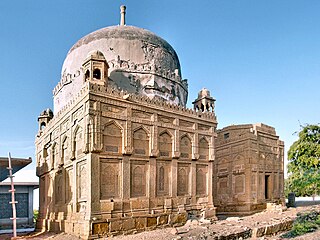
Mirpur Khas is the capital city of the Mirpur Khas District and Mirpur Khas Division in the Sindh province, Pakistan. Mirpur Khas is the 6th largest city in Sindh province and the 34th largest city of Pakistan. The city was built by Talpur rulers of Mankani branch. According to the 2017 Census of Pakistan, its population is 233,916. Mirpur Khas is known for its mango cultivation, with hundreds of varieties of the fruit produced each year - it is also called the “City of Mangoes,” and has been home to an annual mango festival since 1955. After the completion of Hyderabad-Mirpurkhas dual carriage way, the city has become hub of commercial activities.

Sindhology is a field of South Asian studies and academic research that covers the history, society, culture, literature and people of Sindh, Pakistan. The subject was first brought into the academic circles with the establishment of the Institute of Sindhology at Sindh University in 1964. Since then, it has developed into a discipline that covers the aspects of history and archaeology from the Indus Valley civilization to the modern Sindhi society. The subject has also received wider attention at international levels. An academic or expert who specialises in Sindhology is called a Sindhologist.

Sindhi cuisine refers to the distinct native cuisine of the Sindhi people from Sindh, Pakistan. Sindhi cuisine has been influenced by Central Asian, Iranian, Mughal food traditions. It is mostly a non-vegetarian cuisine, with even Sindhi Hindus widely accepting of meat consumption. The daily food in most Sindhi households consists of wheat-based flat-bread (Mani) or rice accompanied by two dishes, one gravy and one dry with curd, papad or pickle. Freshwater fish and a wide variety of vegetables are usually used in Sindhi cuisine. Restaurants specializing in Sindhi cuisine are rare, although it is found at truck stops in rural areas of Sindh province, and in a few restaurants in urban Sindh.

The Chaukhandi tombs form an early Islamic cemetery situated 29 km (18 mi) east of Karachi, Sindh province of Pakistan. The tombs are notable for their elaborate sandstone carvings. The tombs are similar in style to the elaborate tombs at the Makli Necropolis near Thatta, and are built in the funerary architectural style typical of lower Sindh.

The area of Karachi in Sindh, Pakistan has a natural harbor and has been used as fishing port by local fisherman belonging to Sindhi tribes since prehistory. Archaeological excavations have uncovered a period going back to Indus valley civilisation which shows the importance of the port since the Bronze Age. The port city of Banbhore was established before the Christian era which served as an important trade hub in the region, the port was recorded by various names by the Greeks such as Krokola, Morontobara port, and Barbarikon, a sea port of the Indo-Greek Bactrian kingdom and Ramya according to some Greek texts. The Arabs knew it as the port of Debal, from where Muhammad bin Qasim led his conquering force into Sindh in AD 712. Lahari Bandar or Lari Bandar succeeded Debal as a major port of the Indus; it was located close to Banbhore, in modern Karachi. The first modern port city near Manora Island was established during British colonial Raj in the late 19th century.

The Shah Jahan Mosque, also known as the Jamia Masjid of Thatta, is a 17th-century building that serves as the central mosque for the city of Thatta, in the Pakistani province of Sindh. The mosque is considered to have the most elaborate display of tile work in South Asia, and is also notable for its geometric brick work - a decorative element that is unusual for Mughal-period mosques. It was built during the reign of Mughal emperor Shah Jahan, who bestowed it to the city as a token of gratitude, and is heavily influenced by Central Asian architecture - a reflection of Shah Jahan's campaigns near Samarkand shortly before the mosque was designed.
Pakistani architecture is intertwined with the architecture of the broader Indian subcontinent. The major architectural styles popular in the past were Temple, Indo-Islamic, Mughal and Indo-Saracenic architecture, all of which have many regional varieties. With the beginning of the Indus civilization around the middle of the 3rd millennium BC, for the first time in the area which encompasses today's Pakistan an advanced urban culture developed with large structural facilities, some of which survive to this day. This was followed by the Gandhara style of Buddhist architecture that borrowed elements from Ancient Greece. These remnants are visible in the Gandhara capital of Taxila.
Pakistani clothing refers to the ethnic clothing that is typically worn by people in the country of Pakistan and by Pakistanis. Pakistani clothes express the culture of Pakistan, the demographics of Pakistan, and cultures from Punjab, Sindh, Balochistan, Khyber Pakhtunkhwa, Gilgit-Baltistan, and Kashmir regions of the country. The clothing in each region and culture of Pakistan reflect weather conditions, way of living, the textiles and embroidery used and its distinctive style which gives it a unique identity among all cultures.
The cultural history of Karachi goes back at least five thousand years to the emergence of the Indus Valley Civilization in the third millennium BC. The early culture is mostly Neolithic with widespread usage of small cart implements and semi-precious stones. The many megalithic Arab graves around Karachi gave evidence towards megalithic movements of the Arabian Peninsula.

The Muhajir people are Muslim immigrants of various ethnic groups and regional origins, and their descendants, who migrated from various regions of India after the Partition of India to settle in the newly independent state of Pakistan. The community includes those immigrants' descendants, most of whom are settled in Karachi and other parts of urban Sindh. The Muhajir community also includes stranded Pakistanis in Bangladesh who migrated to Pakistan after 1971 following the secession of East Pakistan in the Bangladesh Liberation War.

Shalwar kameez is a traditional combination dress worn by men and women in South Asia, and Central Asia.
Gul Muhammad Khatri (1919–1979) was a renowned artist, painter and writer living in Karachi, Pakistan. He produced art works in the form of portraits, landscape art, and calligraphic illustrations of Sufi poetry. He also did commercial art work in the form of poster design, glass painting, sign board, textile design, theatrical design, cinema posters, tile design as well as Sindhi, Urdu, Hindi, Gujarati and English calligraphy.

The Insurgency in Sindh is a low-intensity insurgency waged by Sindhi Nationalists against the government of Pakistan. Sindhi nationalists want to create an independent state called Sindhudesh. However, this movement never gained support from the populace of urban Sindh.
Haider Ali is a Pakistani painter best known for his work as a truck artist. Around the world, he has painted murals, structures, benches, and trucks in the distinctive truck art style of Pakistan. He first gained international attention in 2002 when he worked on the first authentic Pakistani truck in North America for the Smithsonian and has since exhibited at museums and institutions globally.

Pakistani craft has a long tradition and history. It is a traditional work or art of Pakistani people to produce, design or shape objects by using simple tools or simply by hand. It is generally produced by an individual, group or independent artists, and while it is an ancient custom, artists process traditional craft material such as brass, wood, clay, textiles, paper, or other embroidery material to create handmade items. Stone carving, sandstone, onyx, metalwork, pottery, and ajraks are commonly used techniques and materials to work upon handicrafts.
The crafts of Sindh and its craftsmen are held in high esteem and their works are notable not only in Sindh but also in many other places.






